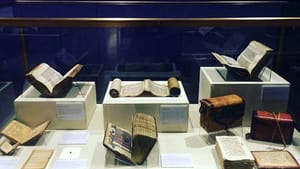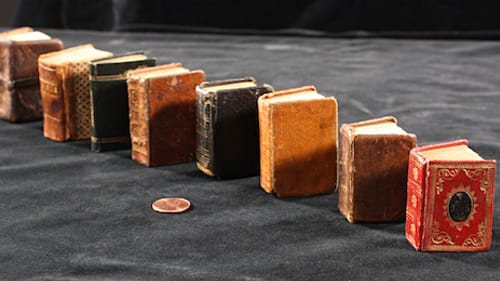Stay in the Loop
BSR publishes on a weekly schedule, with an email newsletter every Wednesday and Thursday morning. There’s no paywall, and subscribing is always free.
Bibliophiles in Wonderland
Free Library of Philadelphia presents 'Big and Small: Books for All'

In the digital world, books are weightless and odorless. Their pages do not crinkle. They float across our screens and vanish into the cloud. Big and Small: Books for All, a family-friendly exhibition at Parkway Central Library, emphasizes that books are things — material objects whose covers, dimensions, and formats are a crucial part of their stories.
Big and Small gathers items from the library’s extensive Rare Book Department. The show is a modestly sized and eclectic display, ranging from a 4,000-year-old cuneiform tag that was suspended from an animal’s neck to identify its owner (the first wearable book?) to a literal accordion book: a Hohner accordion with pages of text glued to its slashed-apart bellows.
“Things that are very large or very small capture the attention of people,” says Joe Shemtov, special collections coordinator of the library’s Rare Book Department. Much of the exhibition plays with the notion of size: Is a big book necessarily a more substantive tome? Is a small book less significant? And what about that clichéd admonition to avoid judging a book by its cover?
“Appearances are deceiving,” Shemtov says, noting the “design” in a 15th-century Masoretic Bible that is actually composed of micrography—calligraphed print so tiny it appears to be mere decoration. A book, he notes, may not look like a book: it may be a scroll, tablet, or box containing unbound pages of text. “With e-books, there’s a tendency to forget that the physicality of the book is important,” he says. “The object itself has its own story, and there is significance to it.”
Bigger isn't always better
The exhibition, true to its title, includes miniscule books—the smallest is the size of a pinky fingernail—and enormous volumes like The New Our Big Book from 1952, an easel-sized Dick-and-Jane primer with text large enough to be legible even by the myopic kindergartener at the back of the room.
With some items, function dictates form: a physician’s guide from 1364, including a “urine wheel” with 20 shades of urine and their corresponding ailments, was designed to hang from a doctor’s belt loop for quick reference. English hornbooks, small wooden paddles with a leaf of paper containing the alphabet and protected by a translucent panel of animal horn, were made for a child to wear as a kind of literary pendant. There’s even a knuckle-sized mini-dictionary from 1875, housed in a silver locket case and complete with a built-in magnifying-glass; its wearer would never be at a loss for words.
Big and Small subverts the notion that “bigger is better.” While some books gain gravitas simply by their heft — recall the 20-volume encyclopedia sets that were once the mark of an erudite home — others have an impact that far outweighs their slim proportions. One vitrine holds pocket-sized paperbacks that, because of their affordability and accessibility, helped boost literacy and democratize the classics. That case also houses 19th-century political pamphlets and a copy of Four Negro Poets, a staple-bound chapbook printed in 1927 and sold for 25 cents, with works by Countee Cullen, Langston Hughes, Claude McKay, and Jean Toomer.

A scattering of miniature books, each one smaller than a flip-phone, ranges from The Inaugural Address of John Fitzgerald Kennedy to The Rubaiyat of Omar Khayyam. The biggest volumes in the collection include the Dick and Jane primer and a Gradual, circa 1425, from Italy—a giant choir book for a Mass, large enough for all the singers to scan it from a distance.
As I wandered from item to item—a 15-foot-long scroll of incantatory prayers from Armenia; a six-inch-high Torah containing, in eye-straining calligraphy, the first five books of the Hebrew Bible; an 1811 perpetual calendar from Turkey, coiled into a cigar-like case — I thought about the touch, size, and heft of the books I’ve loved. I recalled my family’s crammed bookcases: women’s-studies texts next to contemporary novels jimmied up against Shakespeare’s collected plays. I sometimes imagine those volumes speaking to one another, strange shelf-fellows in never-ending conversation.
Redefining books
The creators of Big and Small hope the dialogue will continue. On several “Way-Too-Big Wednesdays” and “Teeny-Tiny Tuesdays,” they’ll show items too large, small, or fragile to be part of the exhibit. Neighborhood libraries will hold book-arts workshops for children, teens, and adults.
The exhibition is bookended, so to speak, by two eye-catching items. At the entrance is a case of books in graduated girths, from the matchbook-sized Gentle Thoughts (1850) to a two-foot-tall Antiphonary, a book of liturgical chants (c. 1675). At the far corner stands a mannequin, with accessories slung on nearby wooden pegs: a hornbook replica, a leather cell-phone case in the style of a medieval girdle book. Visitors can try on these items or sling them over the mannequin’s shoulders. If you’re not paying attention, you might miss the final in-joke: the mannequin’s shirt is another wearable book, printed with the first paragraphs of Alice’s Adventures in Wonderland.
The beauty of “Big and Small” is its reminder that books come in all sizes, shapes, and materials, and that those qualities matter. Once I left the library, the world seemed to teem with texts: the billboards shouting beside the Schuylkill Expressway, the fortune-cookie slip crumpled in my wallet, the political shorthand splayed across the chests of T-shirt-wearing strangers.
What, When, Where
Big and Small: Books for All. Through March 25, 2018, at the Free Library of Philadelphia's Parkway Central Library, 1901 Vine Street, PHiladelphia. (215) 686-5322 or freelibrary.org.
Sign up for our newsletter
All of the week's new articles, all in one place. Sign up for the free weekly BSR newsletters, and don't miss a conversation.
 Anndee Hochman
Anndee Hochman